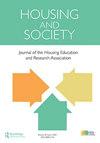Draining a flooded bathtub: a qualitative analysis of Built for zero implementation during COVID-19
Q2 Social Sciences
引用次数: 0
Abstract
ABSTRACTBuilt for Zero (BFZ) is a data-driven approach being adopted by homeless systems in some Anglo countries to allocate permanent housing assistance. BFZ was created and promoted by Community Solutions – a nonprofit advocacy group based in the USA – as an evidence-based way to end homelessness. Despite its growing popularity amongst policymakers, few academic studies have analyzed BFZ implementation. This paper fills that knowledge gap with interviews conducted with 28 US homeless systems. My data analysis answers the following questions: What were the barriers to and enablers of BFZ implementation during the COVID-19 pandemic? How did managerial staff navigate these barriers and exploit these opportunities? What are the ethical implications of these strategies? I demonstrate government responses to COVID-19 facilitated entries into and hindered exits from homeless systems, BFZ communities experimented with risky interventions during the pandemic that have not been systematically tested, and homeless systems need additional resources to equitably implement BFZ.KEYWORDS: Built for zerohomelessnesssystems theorygovernanceCOVID-19coordinated entry Disclosure statementNo potential conflict of interest was reported by the author.DeclarationsI would like to thank the participants who contributed their time to this research and the anonymous reviewers for providing helpful comments on this paper.Availability of data and materialMasked data is available upon request.Notes1. A person experiences chronic homelessness if they live with a disability in a place not meant for human habitation, a safe haven, or in an emergency shelter continuously for at least twelve months or on at least four separate occasions in the last three years, as long as the combined occasions equal at least twelve months (Federal Register, Citation2015).2. Local organizations that do not receive HUD funding can withhold resources from CoC members.3. I cannot provide a real-world example of BFZ communities using the BNL to make program referrals, identify leverage points, and balance feedback loops because such studies do not currently exist. Grainger (Grainger, Citation2022a, Citation2022b) offer the best examples from a non-BFZ community that was using BFZ methodology to allocate permanent housing assistance.4. Benfer et al. (Citation2022) show states like Washington, Oregon, California, New Mexico, Minnesota, Illinois, New York, Vermont, Connecticut, New Jersey, and Maryland banned eviction for nearly one-year.5. Hepburn et al. (Citation2023) show cities like Austin, Minneapolis, New York, Richmond, Philadelphia, and Boston banned evictions for an extended period of time and as a result had lower eviction rates than cities that allowed them to continue.6. The term “Section 8” is commonly used to refer to Housing Choice Vouchers. This is the primary way federal authorities subsidize renters.7. These respondents explicitly described ways they jet chronically homeless clients from their system. I assume that the remaining CoCs in the study do the same because everyone stated that they lacked enough PSH to end chronic homelessness. That said, two participants said service providers in their CoC creamed low acuity clients from the BNL, thereby leaving chronically homeless individuals on the street.Additional informationFundingThe author reports this research was financially supported with a small grant (i.e., Early Career Research Support Fund) that was provided by the University of Glasgow.Notes on contributorsGarrett L. GraingerDr. Garrett L. Grainger is an urban sociologist who has published research on homeless governance in specialist and non-specialist academic journals. He can be reached at glg2000@hw.ac.uk.排水淹水浴缸:COVID-19期间“为零而建”实施的定性分析
【摘要】“为零而建”(built for Zero,简称BFZ)是一些盎格鲁国家无家可归者制度为分配永久性住房援助而采用的数据驱动方法。BFZ是由社区解决方案(一个总部设在美国的非营利倡导组织)创建和推广的,作为一种以证据为基础的结束无家可归的方法。尽管它在政策制定者中越来越受欢迎,但很少有学术研究分析BFZ的实施情况。本文通过对28个美国无家可归者系统的访谈填补了这一知识空白。我的数据分析回答了以下问题:在COVID-19大流行期间,实施BFZ的障碍和推动因素是什么?管理人员是如何克服这些障碍并利用这些机会的?这些策略的伦理含义是什么?我展示了政府对2019冠状病毒病的应对措施,为无家可归者系统的进入提供了便利,并阻碍了他们的退出,无家可归者社区在大流行期间试验了未经系统测试的高风险干预措施,无家可归者系统需要额外的资源来公平地实施无家可归者系统。关键词:为零无家可归者而建系统理论治理covid -19协调入境披露声明作者未报告潜在利益冲突声明我要感谢为这项研究贡献时间的参与者和匿名审稿人,他们对本文提供了有益的意见。数据和材料的可用性根据要求可提供遮罩数据。如果残疾人在非人类居住场所、安全避难所或紧急避难所连续居住至少12个月,或在过去三年中至少四次单独居住,只要这些情况合计至少12个月,即为长期无家可归(《联邦公报》,Citation2015)。没有获得住房和城市发展部资助的地方组织可以扣留CoC成员的资源。我无法提供BFZ社区使用BNL进行程序推荐、确定杠杆点和平衡反馈循环的实际示例,因为目前还不存在这样的研究。Grainger (Grainger, Citation2022a, Citation2022b)提供了一个使用BFZ方法分配永久性住房援助的非BFZ社区的最佳例子。Benfer等人(Citation2022)显示,华盛顿州、俄勒冈州、加利福尼亚州、新墨西哥州、明尼苏达州、伊利诺伊州、纽约州、佛蒙特州、康涅狄格州、新泽西州和马里兰州禁止驱逐近一年。赫本等人(Citation2023)表明,奥斯汀、明尼阿波利斯、纽约、里士满、费城和波士顿等城市在很长一段时间内禁止驱逐,因此驱逐率低于允许驱逐的城市。术语“第8节”通常用于指住房选择券。这是联邦政府补贴租房者的主要方式。这些受访者明确描述了他们如何将长期无家可归的客户从他们的系统中剔除。我认为研究中剩下的coc也会这样做,因为每个人都说他们缺乏足够的PSH来结束长期的无家可归。也就是说,两名参与者表示,他们的CoC中的服务提供者从BNL中挑选了低视力的客户,从而使长期无家可归的人流落街头。作者报告说,这项研究得到了格拉斯哥大学提供的小额资助(即早期职业研究支持基金)的财政支持。作者简介garrett L. grainger博士。Garrett L. Grainger是一位城市社会学家,他在专业和非专业学术期刊上发表了关于无家可归者治理的研究。您可以通过glg2000@hw.ac.uk与他联系。
本文章由计算机程序翻译,如有差异,请以英文原文为准。
求助全文
约1分钟内获得全文
求助全文
来源期刊

Housing and Society
Social Sciences-Urban Studies
CiteScore
2.30
自引率
0.00%
发文量
10
期刊介绍:
Housing and Society is the journal of the Housing Education and Research Association (HERA). The journal supports the mission of HERA by providing for the dissemination of research and other scholarly work. Submissions from a broad range of perspectives are encouraged. Topics in housing include: policy, design, social aspects, gerontology, behavioral aspects, energy/environment, equipment, interiors, economics, theory/model development, education, and program development or evaluation. The journal welcomes the submission of original research articles, notes and commentaries. Notes are shorter manuscripts presenting succinct information on housing related to one of the following categories: - Research: exploratory or not heavily theory-based or statistically analyzed - Academic: innovative teaching ideas - Program: development, implementation, and/or evaluation of Cooperative Extension or other housing programming efforts - Policy: examination of policy impact, comparative analysis, and/or need to achieve housing goals - Reviews: books, documentaries, etc.
 求助内容:
求助内容: 应助结果提醒方式:
应助结果提醒方式:


